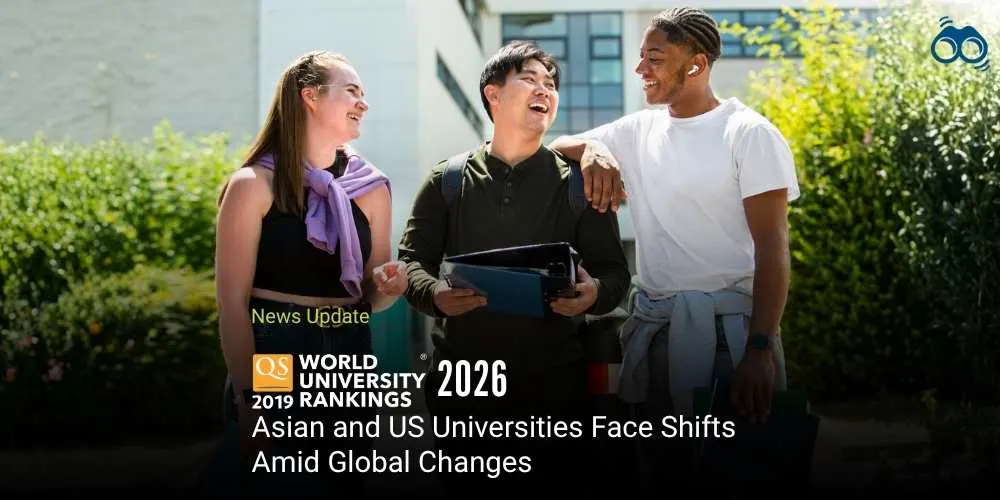New Players Emerge as Traditional Education Powers Face Pressure
2026 World University Rankings Reveal Stalled Asian Rise, US Decline
The 2026 Times Higher Education World University Rankings have uncovered a dramatic change in global academic performance. For the first time in 14 years, Asia's leading universities have had their advance slow down, and US universities keep on falling, even before the complete effects of the Trump administration's policies on higher education are evident in the figures. The University of Oxford has again been the world's number one institution for a record tenth year in succession, once more asserting the UK's ongoing dominance at the head. Top-flight institutions in Asia, though, have indicated stagnation. Tsinghua University held the 12th spot for the third year in succession, and Peking University took 13th for the second year running. Likewise, the National University of Singapore (NUS) remained at 17th position. The total number of Chinese universities in the top 200 also remained stationary at 13, reflecting a plateau in performance.
This stability is in contrast to Asia's previous decade of super-fast ascension on the Global University Ranking, where Tsinghua, Peking, and NUS all leapt hugely in ranking. Specialists explained that this year's slowdown does not indicate the decline of Asia's ascension, but is a time for self-adjustment based on national policy constraints and structures of funding. Outside the best performers, East and Southeast Asia continued to show strong performance. Hong Kong recorded a record six places in the top 200, fueled by enhanced teaching reputation and improved student-to-staff ratios. South Korea also made solid gains, with four universities now in the top 100 after advances in research quality. The University of Tokyo jumped to 26th, its best position ever, although Japan as a whole saw fewer universities advance than last year.
China’s performance stood out, with 21 per cent of its universities improving and 18 achieving their best-ever rankings. The country now boasts five institutions in the top 40, up from three in 2025, supported by strong investments in research and innovation. But experts noted that entering the Top 10 Universities of the World is still challenging. Chinese universities, while leading in research revenues and innovation, still trail in terms of international orientation and research quality vis-à-vis the US and UK universities. Rajika Bhandari, director of an international education strategy company, noted that Asian universities were being held back by government intervention, limited freedom to pursue scholarship, and a lack of adequate support for basic research.
The US University Rankings had mixed messages. The top tier remained dominated by American universities, which occupied seven of the first ten positions. The Massachusetts Institute of Technology (MIT) retained the second position internationally, and Princeton University rose to joint third — a record high — due to significant gains in teaching and research. But the US as a whole slipped, with 35 institutions in the top 100, from 38 last year. Others, like the University of Chicago, Columbia University, and Duke University, reached their historic lows. Pundits cautioned that as the implications of dwindling funds and limitations on global cooperation begin to manifest in statistics, the slide is likely to further accelerate. The academics pointed out that Donald Trump's administration has been opposed to the academic community, and if such pressures persist, the US could suffer from a "brain drain" as scholars and students look elsewhere for opportunities.
Notwithstanding this, analysts like Oxford's Simon Marginson opined that the US's long-standing image as a higher education leader would not disappear overnight, given that the nation still attracts international brains. The performance of the UK continued to be good at the top, with Cambridge University (joint third), Oxford, and Imperial College London (eighth) all figuring in the top ten. But most other British universities have fallen behind. Of the 105 UK universities covered, 27 per cent fell behind and just 12 per cent moved up. The London School of Economics and the University of Warwick both slumped to their lowest-ever rankings.
The number of UK universities ranking within the world's top 500 has dropped below 50 for the first time. Oxford Vice-Chancellor Irene Tracey said Oxford's number one ranking was a source of pride, but it arrived "at a time of real strain for UK higher education," urging fresh investment and support. A spectre of population decline also looms over university performance in Asia, the US, and Europe. University intakes are declining, particularly in South Korea, Japan, and Taiwan. Without more vigorous international recruitment and collaborations, experts cautioned that universities risk less research capability and competitiveness.
However, the long-term outlook for Asia is still upbeat, according to analysts. The region's governments continue to spend a lot on research and education, which could ease demographic pressures. Beyond the established education champions, there are emerging players to watch. Australia has indicated a post-pandemic rebound, and Italy has gained through increased spending on research. Meanwhile, the traditional Western European champions such as Germany, France, and the Netherlands fell slightly. Emerging economies like Turkey, Poland, and Indonesia have shown significant improvement in their average scores. Indonesia has particularly demonstrated a quick acceleration, with 35 universities featured this year from only one a decade ago, a reflection of the increasing globalisation of the academic environment.
Bhandari pointed out that the international scholarly environment was experiencing "a moment of great flux," as research skills were increasingly transferring away from the US and UK to emerging education hubs in Asia and beyond. The 2026 World University Rankings reflect a nuanced scenario: the leading universities in Asia are temporarily stable, US institutions are under pressure, and UK universities are struggling with funding. But new players from around the globe are arising with solid research aspirations. The future of global higher education will hang in the balance as universities respond to funding pressures, demographic transformation, and needs for international collaboration.
Editor's Note
The 2026 Times Higher Education World University Rankings are a watershed in world-level academic performance. Oxford's tenth year running at the number one position is the UK's moment to be proud, yet it also underlines a more fundamental issue: the country's broader university sector is falling behind. With fewer UK universities among the top 500 and some falling in ranking, the message is clear: prestige at the top cannot cover up systemic stress. New money and sustained investment are desperately required. Asia's phenomenal growth has slowed, not turned back. The resilience of leading performers such as Tsinghua and NUS indicates a time to take stock, not withdraw. Funding models and national policy restrictions are determining outcomes, and although China's research-driven expansion is phenomenal, internationalisation is still a hurdle to joining the top group. The US is still supreme at the top, but the cracks are beginning to show. Lower numbers of universities in the top 100, record lows for leading institutions, and increasing worry over funding and international collaboration indicate an industry in distress. If trends persist, the US stands the chance of losing its competitive edge—not through a dearth of talent, but through policy decisions isolating instead of backing it. At the same time, new challengers such as Indonesia, Turkey, and Poland are transforming the landscape. Their ascension is not merely symbolic but a manifestation of a change in where research capability and aspiration are expanding. The world scholarly landscape is no longer dominated by the erstwhile titans.
Skoobuzz observes that this year’s rankings are not just numbers; they show that higher education is changing. Falling student numbers, funding problems, and the need to work with others around the world are big challenges. Universities must adapt, not just to stay competitive, but to stay relevant in a fast-changing world.
FAQs
1. What are the major shifts in the 2026 World University Rankings?
The biggest change is that Asia’s top universities have stopped rising after years of fast progress. The US still has many top universities, but several have dropped in rank. The UK’s Oxford University stayed at number one for the tenth year, but many other British universities fell behind. Meanwhile, countries like India, Indonesia, Turkey, and Poland showed strong improvement, with more universities entering the global list.
2. Which Asian universities rose in the 2026 rankings?
China had five universities in the top 40, up from three last year. Hong Kong placed six universities in the top 200, a record for the region. South Korea now has four universities in the top 100. India also made gains, with the Indian Institute of Science moving into the 201–250 band and several others climbing into higher rank groups.
3. Why are US universities losing ground in global rankings?
Some top US universities, like Harvard and Columbia, dropped in rank. Experts say this is due to reduced funding, less support for research, and fewer international partnerships. Political decisions have also made it harder for international students and scholars to come to the US, which affects global reputation and research output.
4. How does Times Higher Education calculate world university rankings?
They use 18 different indicators to measure performance. These include teaching quality, research strength, international outlook, and how well universities share knowledge with industry. Each university is scored across these areas to create a balanced ranking.
5. What global changes are influencing university rankings in 2026?
Several big changes are shaping the rankings. Population decline is reducing student numbers in places like Japan, South Korea, and Europe. Funding cuts are hurting research in the US and UK. At the same time, emerging countries are investing more in education and research. There’s also a shift in global talent, with more scholars moving to new education hubs in Asia and beyond.














0 Comments (Please Login To Continue)